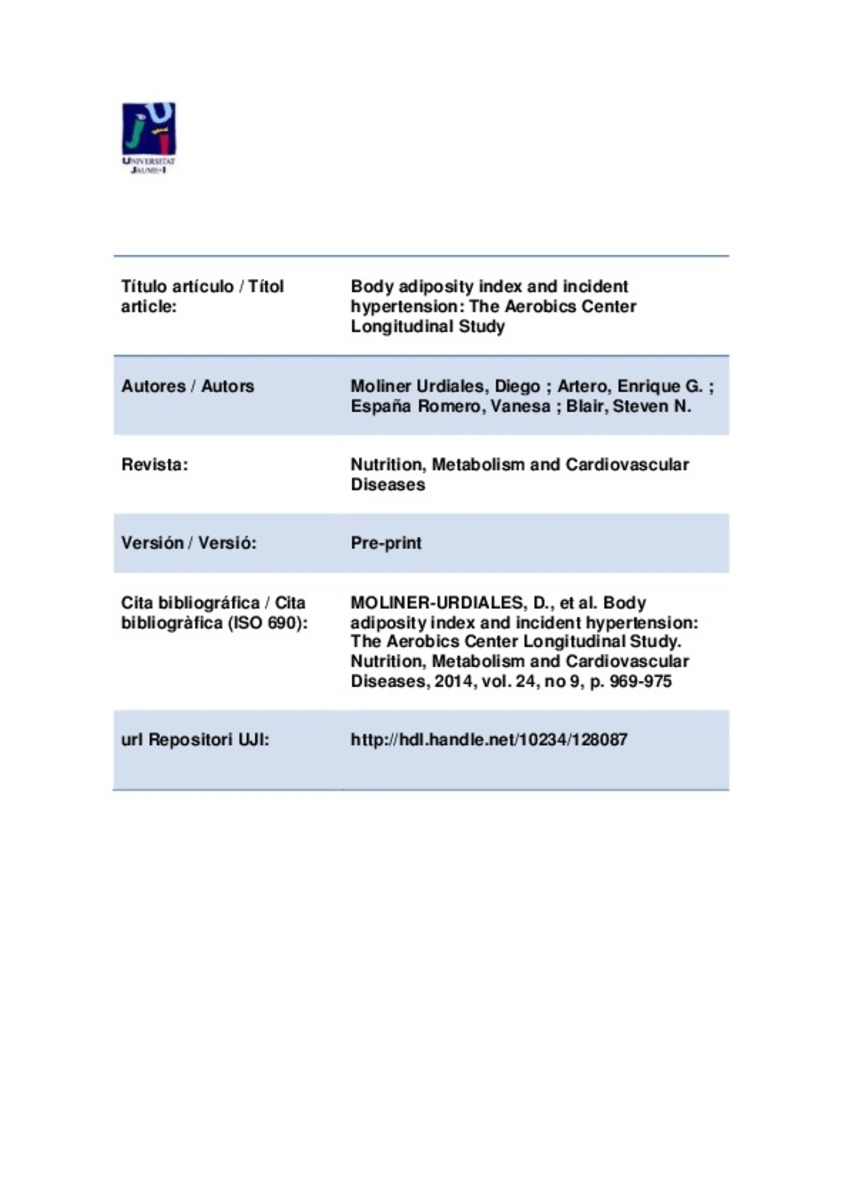Mostrar el registro sencillo del ítem
Body adiposity index and incident hypertension: The Aerobics Center Longitudinal Study
| dc.contributor.author | Moliner-Urdiales, Diego | |
| dc.contributor.author | Artero, Enrique G. | |
| dc.contributor.author | España Romero, Vanesa | |
| dc.contributor.author | Blair, Steven N. | |
| dc.date.accessioned | 2015-07-20T09:44:13Z | |
| dc.date.available | 2015-07-20T09:44:13Z | |
| dc.date.issued | 2014 | |
| dc.identifier.citation | MOLINER-URDIALES, D., et al. Body adiposity index and incident hypertension: The Aerobics Center Longitudinal Study. Nutrition, Metabolism and Cardiovascular Diseases, 2014, vol. 24, no 9, p. 969-975. | ca_CA |
| dc.identifier.issn | 0939-4753 | |
| dc.identifier.issn | 1590-3729 | |
| dc.identifier.uri | http://hdl.handle.net/10234/128087 | |
| dc.description.abstract | Background and aim The body adiposity index (BAI) has been recently proposed as a new method to estimate the percentage of body fat. The association between BAI and hypertension risk has not been investigated yet. The aim of our study was to evaluate the ability of BAI to predict hypertension in males and females compared with traditional body adiposity measures. Methods and results The present follow-up analysis comprised 10,309 individuals (2259 females) free of hypertension from the Aerobics Center Longitudinal Study, who completed a baseline examination between 1988 and 2003. Body adiposity measures included BAI, body mass index (BMI), waist circumference, hip circumference, percentage of body fat and waist to hip ratio (WHR). Incident hypertension was ascertained from responses to mail-back surveys between 1990 and 2004. During an average of 9.1 years of follow-up, 872 subjects (107 females) became hypertensive. Hazard ratios (HRs) and 95% confidence intervals (95% CI) showed that males in the highest categories of all body adiposity measures showed a higher incident risk of hypertension (HRs ranged from 1.37 to 2.09). Females showed a higher incident risk of hypertension only in the highest categories of BAI, BMI and WHR (HRs ranged from 1.84 to 3.36). Conclusion Our results suggest that in order to predict incident hypertension BAI could be considered as an alternative to traditional body adiposity measures. | ca_CA |
| dc.description.sponsorShip | The authors thank the Cooper Clinic physicians and technicians for collecting the data, and staff at the Cooper Institute for data entry and data management. This work was supported by “Conselleria de Educación de la Generalitat Valenciana” [BEST/2012/257]; Spanish Ministry of Education [EX-2010-1008]; National Institutes of Health [AG06945, HL62508, R21DK088195] and in part by an unrestricted research grant from The Coca-Cola Company. The content is solely the responsibility of the authors and does not necessarily represent the official views of the funding institutions. | ca_CA |
| dc.format.extent | 7 p. | ca_CA |
| dc.format.mimetype | application/pdf | ca_CA |
| dc.language.iso | eng | ca_CA |
| dc.publisher | Elsevier | ca_CA |
| dc.relation.isPartOf | Nutrition, Metabolism and Cardiovascular Diseases, 2014, vol. 24, no 9 | ca_CA |
| dc.rights | Copyright © Elsevier B.V. | ca_CA |
| dc.rights.uri | http://rightsstatements.org/vocab/InC/1.0/ | * |
| dc.subject | obesity | ca_CA |
| dc.subject | blood pressure | ca_CA |
| dc.subject | adiposity | ca_CA |
| dc.subject | body composition | ca_CA |
| dc.subject | adults | ca_CA |
| dc.title | Body adiposity index and incident hypertension: The Aerobics Center Longitudinal Study | ca_CA |
| dc.type | info:eu-repo/semantics/article | ca_CA |
| dc.identifier.doi | http://dx.doi.org/10.1016/j.numecd.2014.03.004 | |
| dc.rights.accessRights | info:eu-repo/semantics/openAccess | ca_CA |
| dc.relation.publisherVersion | http://www.sciencedirect.com/science/article/pii/S0939475314001100 | ca_CA |
Ficheros en el ítem
Este ítem aparece en la(s) siguiente(s) colección(ones)
-
EDU_Articles [501]







